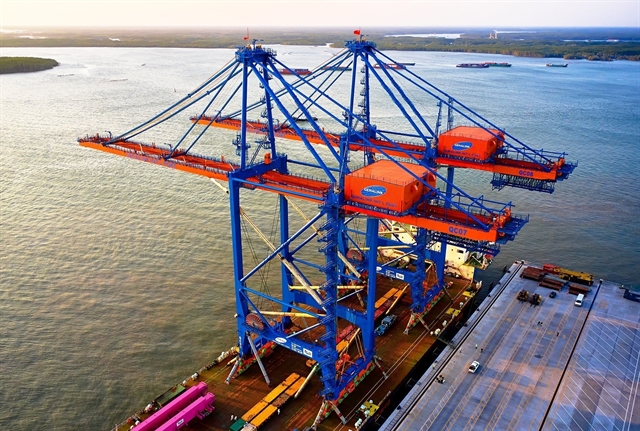
|
| A view of a seaport in the southern province of Bà Rịa-Vũng Tàu. Shipping costs to the EU and the US have been on the rise, following recent geopolitical tension around the world. VNA/VNS Photo |
HÀ NỘI – Shipping fees for major routes from Việt Nam to the EU and the US have surged significantly, cutting into exporters’ profits as they have had to spend thousands of dollars in additional cost, said industry insiders and experts.
In recent weeks, prices have increased sharply with the cost to transport a container to Europe reaching US$4,000-5,000, more than double what it was during the same period last year. Similarly, shipping costs to the US have increased to $6,000-7,000 for a container.
Meanwhile, transport costs per container to closer destinations including China, Japan, South Korea and Southeast Asia have also increased by an additional $1,000-2,000.
With shipping costs mounting, exporters have raised concerns over the shrinking profit margin and how it will hurt their ability to compete in the international market.
The CEO of a fruit export company located in the southern province of Đồng Nai said his company had seen shipping bills totalling hundreds of thousands of dollars since the beginning of the year. With an average of 100 shipments per month, it had been costing him a fortune every month as shipping costs to Europe increased by $2,500 and to the US by $3,500-4,500 per container.
He said it would be tricky to keep prices competitive at this rate as businesses had other costs they must also cover.
Nguyễn Đình Tùng, director-general of Vina T&T Group said as of last month, the average cost to ship a container from Việt Nam to the US reached as high as $8,700. Since then, it had cooled significantly to $6,000 per container, but was still nearly double the cost recorded at the end of last year.
On average his business ships out two to three containers a day, effectively making his transport bills tens of thousands of dollars daily, according to Tùng. If he cannot renegotiate contracts with customers, delivery costs will fall on his business.
Nguyễn Văn Kịch, chairman and CEO of Cafatex Corporation in the southern province of Cần Thơ said Vietnamese seafood export companies had been struggling to keep up with the rising transport costs.
He said for each container going to the US, costs had increased by nearly VNĐ100million.
“Companies have been seeking support from business partners or new markets but most likely, many of them will have to consider reducing exports,” he said.
Kịch said even when money was no object, it was still a challenge to book a ship because of the ongoing severe shortage of containers.
“The demand of the Chinese market is simply too great. They are willing to pay more to secure the boxes,” Kịch added.
Industry insiders said the shortage had never been addressed since the COVID-19 pandemic. It had also been made worse by recent geopolitical tension around the world.
Đặng Phúc Nguyên, secretary-general of the Vietnam Fruit and Vegetable Association, said the container shortage and rising transport costs had negatively affected Vietnamese businesses, whose large customers include markets in the EU and the US.
In addition, Chinese exporters had been willing to put down large sums of money to book containers in advance, driving prices even higher.
Trương Quốc Hòe, secretary-general of the Vietnam Seafood Association, said Vietnamese businesses relied heavily on foreign shipping companies, making themselves highly vulnerable to price hikes during times of limited supply.
“It has been said within the industry that some companies may reduce the number of available ships during difficult economic situations. This often produced the adverse effect of driving prices even higher,” he said.
The Ministry of Industry and Trade recommended businesses explore alternative routes and means of transport as a cost-cutting measure. However, industry experts said it was only possible for small orders and short-term contracts. Rerouting goods may also introduce additional customs duties and procedures, complicating and prolonging the delivery. VNS
- Reduce Hair Loss with PURA D’OR Gold Label Shampoo
- Castor Oil Has Made a “Huge” Difference With Hair and Brow Growth
- Excessive hair loss in men: Signs of illness that cannot be subjective
- Dịch Vụ SEO Website ở Los Angeles, CA: đưa trang web doanh nghiệp bạn lên top Google
- Nails Salon Sierra Madre
 VnExpress News The News Gateway of Vietnam
VnExpress News The News Gateway of Vietnam




